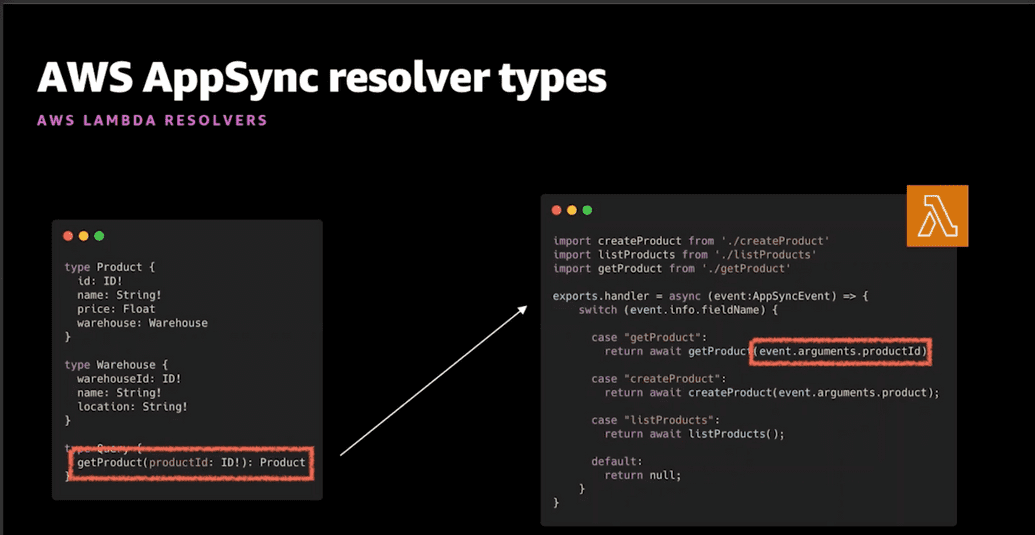Notes from AppSync sessions @ Re:Invent 2020
Tomasz Łakomy
—December 31, 2020
Notes from AppSync sessions @ Re:Invent 2020
More like Re:Mote 2020
Notes from Unify access to siloed data with AWS AppSync GraphQL resolvers by Nader Dabit
Three types of AppSync Resolvers:
- Direct (directly map a GraphQL operation into a data source - DynamoDB, ElasticSearch or Aurora Serverless)
- Lambda resolvers
- HTTP resolvers
$context object
The $context object is a map that holds all of the contextual information for your resolver invocation
$context contains:
arguments- a map that contains all GraphQL arguments for this fieldsource- a map that contains the resolution of the parent fieldresult- (available only in the response mapping template) a container for the results of this resolveridentity- (available only for authenticated requests) an object that contains information about the callerrequest- additional metadata about the request, including the headersinfo- (GraphQL specific) an object that contains information about the GraphQL request (e.g.fieldName,variablespassed in to the query etc. andselectionSetList- fields that we want to return from a query)
Lambda resolvers
- The same
contextobject is passed to the Lambda function (apart from the result, since we return whatever the Lambda function returns)
AppSync deployment options:
- AWS Amplify
- AWS CDK
- Serverless framework
- AWS CloudFormation (obviously)
AppSync is well supported with Amplify, there are certain things that are (currently?) only available in Amplify CLI such as Amplify DataStore.
Adding an AppSync API with Amplify CLI is as simple as running amplify add api.
Apart from Amplify, we can also use CDK (💙) to provision an AppSync API, as an example:
import * as appsync from '@aws-cdk/aws-appsync';const api = new appsync.GraphqlApi(this, 'Api', {name: 'my-awesome-appsync-api',schema: appsync.Schema.fromAsset(path.resolve(__dirname, '../../../schema.graphql'),),authorizationConfig: {defaultAuthorization: {authorizationType: appsync.AuthorizationType.API_KEY,},// Other authorization types (such as Cognito) are also supported},xrayEnabled: true,});const notesLambda = new lambda.Function(this, 'AppSyncNotesHandler', {runtime: lambda.Runtime.NODEJS_12_X,handler: 'appsync.handler',code: lambda.Code.fromAsset('lambda-fns'),});const lambdaDataSource = api.addLambdaDataSource('lambdaDataSource',notesLambda,);
Docs: https://docs.aws.amazon.com/cdk/api/latest/docs/aws-appsync-readme.html
In order to define a subscrpiton in a GraphQL schema with AppSync, we need to use @aws_subscribe directive e.g.:
type Subscription {onCreatePost: Post@aws_subscribe(mutations: ["createPost"])}
Notes from Best practices to securely operate GraphQL at scale with AWS AppSync by Brice Pellé
AppSync provides enterprise security features such as:
- AWS WAF
- Auth2 modes
- access controls
- monitoring
Production-ready GraphQL requirements:
Protect access:
- Only authorized access
- Support multiple access patterns
Protect performance:
- Monitor constantly
- Analyze in real time
- Improve over time
Protect availability:
- Maintain service uptime
- Limit availability to trusted services
- Block bad actors
Deploy reliably:
- Infrastructure as code
- Repeatable
Appsync always requires some sort of authorization in order to access your API - no anonymous access is allowed.
AppSync Authorization Modes:
- API key
- OpenID Connect (with JWT)
- Amazon Cognito User Pools (with JWT)
- IAM
It's up to us to choose the right authorization mode to fit the access use case.
API Key
- Uses HTTP header
x-api-key - Hardcoded in application
When to use:
- Getting started
- With public APIs
- No specific authorization requirements
Cognito User Pools
- Sign in with Amazon Cognito User Pools
- Use JWTs
When to use:
- Authenticating users in app
- Connecting social identities
- Interacting with other AWS services
Granual access control with AppSync directives:
type Query {posts:[Post!]!@aws_auth(cognito_groups: ["Bloggers", "Readers])}
OpenID Connect
- Sign in with OIDC idP
- Use JWTs
When to use:
- Existing user directory
- Authenticating users in app
- Not interacting with other AWS services
IAM
- Backend systems
- AWS credentials
- IoT systems
When to use:
- Amazon EC2 instances
- AWS Lambda functions
AppSync allows us to use all those authorization modes at the same times on a single API 🤯
Protecting availability of an AppSync API
- AppSync provides DDoS protection for any API that we configure
- AWS WAF (Web Application Firewall) is also supported
AWS WAF: Use cases with AWS AppSync
- Protect against flooding
- Turn off introspection (make your schema not discoverable)
- Support B2B APIs using API key
- Limit access to Amazon VPC resources only
Protecting performance of an AppSync API
- AppSync supports CloudWatch by default (and CloudWatch metrics/alerts)
- AppSync also integrates with AWS X-Ray
- AppSync Cache
AppSync Cache
Caching
- Managed server-side caching
- Full API caching
- Per resolver caching
- Encryption
More info from the docs:
AWS AppSync’s server-side data caching capabilities reduce the need to directly access data sources by making data available in a high speed in-memory cache, improving performance and decreasing latency.
AWS AppSync hosts Amazon ElastiCache Redis instances in the AppSync service accounts, in the same AWS Region as your AppSync API.
Caching policies:
- None - no server-side caching (no shit)
- Full request caching - If the data is not in the cache, it will be retrieved from the data source and populate the cache until the TTL expiration. All subsequent requests to your API will be returned from the cache, which means data sources won’t be contacted directly unless the TTL expires.
- Per-resolver caching - With this setting, each resolver needs to be opted in explicitly for it to cache responses. A TTL and caching keys can be specified on the resolver.
Cache encryption:
- Encryption in transit - requests between AppSync, the cache, and data sources (except insecure HTTP data sources) will be encrypted at the network level. Because there is some processing needed to encrypt and decrypt the data at the endpoints, enabling in-transit encryption can have some performance impact.
- Encryption at rest - Data saved to disk from memory during swap operations will be encrypted at the cache instance. This setting also carries a performance impact.

